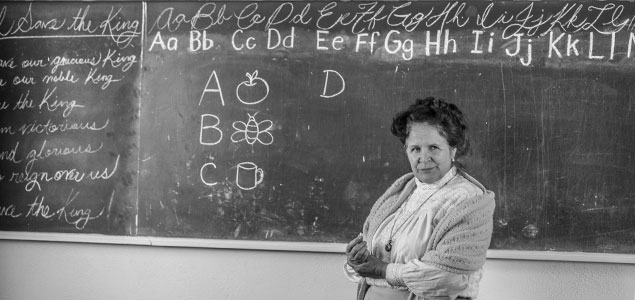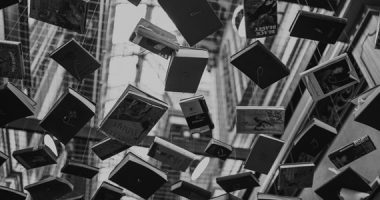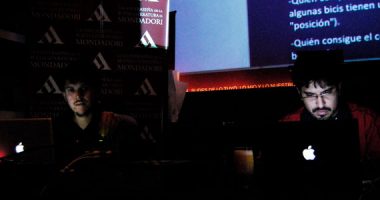
Teacher. N/D. Source: Flickr.
We map out an overview of experimental writing today, focusing particularly on conceptualism and processes of appropriation and expropriation in America, both North and South.
“I only quoted quotes”
Pablo Katchadjian
La cadena del desánimo (Blatt & Ríos, 2013)
In national terms, the most intense examples of political documentary poetry produced in the last few years can probably be found in Mexican literature. Three of them could even be ordered according to the historical period that they refer to –rather than their year of publication– as a way of generating a reading of the history of Mexico connected with its successive empires and, through them, with global networks of capitalism and violence. To start with, La sodomía en la Nueva España (Pre-textos, 2010), by Luis Felipe Fabre, addresses the Holy Inquisition’s repressive policies against homosexuals by juxtaposing his own poetry with extracts from the proceedings of torture and executions, setting up a complex dialogue between the poetry of the Golden Age and today’s poetry, which reflects the polysemy of the concept of “gender”. Meanwhile, in A-H. Anti-Humboldt: Una Lectura del Tratado de Libre Comercio de América del Norte, firmado por Canadá, Estados Unidos y México (2014), Hugo García Manríquez uses the text of the US free trade agreement (1992-1994), highlighting some of its words and phrases and using them to create a poem that counters the official document, which remains in the background, somewhat blurry, ghostly, expropriated. Lastly, Sara Uribe’s Antígona González. Instrucciones para contar muertos (Surplus, 2012), also works on two levels: on one hand, the universal history of Antigones in search of their brothers, and on the other, the testimonies of survivors of the extreme narco-violence of recent years: 21st century Mexico.
The point of departure for a Latin American overview of conceptual literature at the turn of this century could be Fabre’s Leyendo agujeros. Ensayos sobre (des)escritura, antiescritura y no escritura (Tierra Adentro, 2005), which maps connections between the work of Ramón López Velarde, Néstor Perlongher, Ulises Carrión, Nicanor Parra and Roberto Bolaño. The masters. “To read holes is to understand that the gaps and hollows that wound a text are also writing: they are the Braille of the disappeared,” we read; “the texts I broach here can be considered ‘post-poems’, insofar as texts resulting from the disappearance of a word, a verse, or a stanza, or built on the absence of another poem.” Or of people who are absent. A line from Perlongher’s poem about forced disappearances in Argentina, “Hay Cadáveres”, could lead us to Rodrigo Rey Rosa’s El material humano (Anagrama, 2009), which inquires into the thousands of victims of Guatemala’s civil war through archival material; and then to Antígona González.
Modified documents, abused bodies. What are the strongest tensions that literature is subjected to at this turn of the century? I would say it is those that have fiction at one extreme, and narrative journalism, critique, autobiography and the body at the other. Fiction and documentary? Polarisation is impossible: the spectre, nuances, fluctuations, prevail. Screens and politics cut through these tensions. It is difficult to consider them without drawing on the ways in which contemporary art has influenced these same issues over the last few decades. It is no accident that García Manríquez highlights the word “use” in his poem, repeating it in bold text on one of the pages, creating a cloud of insects against a background of the prose of the free trade agreement. Or that in the theoretical text that accompanies his poetic intervention he writes: “Instability is another word for reading.”
In April this year, Jean-Yves Jouannais completed the project L’Encyclopédie des guerres, a series of lectures imparted at the Centre Pompidou in Paris, a kind of live writing of an encyclopaedic work, a possible seven-year performance dedicated to the production of literature in the heart of contemporary art. In his highly recommended essay Artistes sans oeuvres (Éditions Hazan, 1997), Jouannais explores one of the margins of literature through a series of extraordinary characters who would have been great writers if they had written books instead of dedicating themselves to writing letters and private diaries, conversing, strolling, and simply looking. Geniuses of ideas, not of their translation into written form. Artists of concepts. The book dates from 1997, the close of the twentieth century. The lecture series dates from right now. Between these two dates, particularly in America, there has been a proliferation of a new, postmodern consciousness, unwitting heir to these authors without an oeuvre: a conceptual writing that turns towards the arts from the perspective of literature. It is the flipside of the literary sphere’s turn towards the art institution, at least since Art & Language.
Most of the examples that Jouannais includes in his book are French (with the most forceful exception being Borges, as is usually the case). Other anthologies or scholarly projects on conceptual literature also tend to favour a local scene. Escritura experimental en España, 1963-1983, an exhibition recently curated by Javier Maderuelo at the Círculo de Bellas Artes, featured poets and artists such as Juan Eduardo Cirlot, Isidoro Valcárcel Medina, Concha Jerez, José-Miguel Ullán and Jorge Oteiza. In spite of its title which suggests an anthology of experimental literature Escrituras objeto. Antología de literatura experimental (Interzona, 2014), compiled by Tomás Vera Barros, focuses exclusively on Argentinean authors (Arturo Carrera, Leónidas Lamborghini, Alejandro López, Mauro Césari, Belén Gache, Ezequiel Alemian, Pablo Katchadjian, charly.gr and Luis Espinosa). Meanwhile, in Against Expression. An Anthology of Conceptual Writing (Northwestern University Press, 2011), Kenneth Goldsmith and Craig Dworkin principally select English-speaking authors, notwithstanding some important, mainly French, exceptions (Diderot, Roussel, Perec, Cendrars…). And in her key essay Unoriginal Genius: Poetry by other Means in the New Century (Chicago University Press, 2010) Marjorie Perloff follows the same strategy: Walter Benjamin and Brazilian Concrete Poetry are mainly analysed as crucial links in a genealogy that leads to the poetics of North American authors such as Susan Howe, Charles Bernstein and Goldsmith himself.
Although neither of the books include Spanish or Latin American authors, they both nonetheless open up doorways to comparative literature and to an awareness that conceptual poetry is in fact a global phenomenon. Meanwhile, Perloff pays close attention to the work of Caroline Bergvall, a writing artist of French-Norwegian origins based in England who works across languages and media. And behind the anthology of conceptual writing there is UbuWeb, which is undoubtedly the most important and ambitious project relating to the study and global dissemination of avant-garde literature, art, and film, and has been directed by Goldsmith since 1996. Its circle of interlocutors is no secret, given that Bernstein and Perloff are members of UbuWeb’s Board of Directors. Perloff also wrote the afterword for Fidget (Coach House Books, 1994), an extreme exercise reminiscent of Becket, in which Goldsmith strips back fiction as far as possible through the exhaustive description and documentation of all the movements of his body on 16 June, Bloomsday, one year.
In that same country, the United States, we find two double agents: two Latin American writers who bridge the conceptual literature written in the two languages. On one hand, Cristina Rivera Garza –a Mexican writer based in San Diego– who broadens the field of study and reflection, starting out from the extreme violence in Mexico and its interpretations in the form of documentary poetry, and also bringing into play North American documentary poets, the creative processes of Spanish author Agustín Fernández Mallo, and the post-exoticism of unclassifiable French writer Antoine Volodine in Los muertos indóciles. Necroescrituras y desapropiación (Tusquets, Mexico, 2013). And on the other hand, Reinaldo Laddaga –a New York-based Argentinean writer– who, in his latest book, Things that a Mutant Needs to Know: More Short and Amazing Stories (Unsounds, 2013), works on the intersections between English and Spanish, between literature and music (inviting various musicians to perform the pieces from an imaginary continuation of the Cuentos breves y extraordinarios edited by Bioy and Borges) and between the different formats in which we store and disseminate culture (beautifully designed books, CDs, e-books). Laddaga prefaces the Spanish translation of Goldsmith’s essay Uncreative Writing (Escritura no creativa, soon to be published by Caja Negra); and Rivera Garza translated Robert Fitterman and Vanessa Place’s Notes on conceptualism (Notas sobre conceptualisms, Conaculta, 2013). Both are ultimately frontier writers, translators of cultures, a figure that is absolutely essential for understanding this international repertoire of trans-artistic strategies that we call “appropriation” and “expropriation”.






Leave a comment